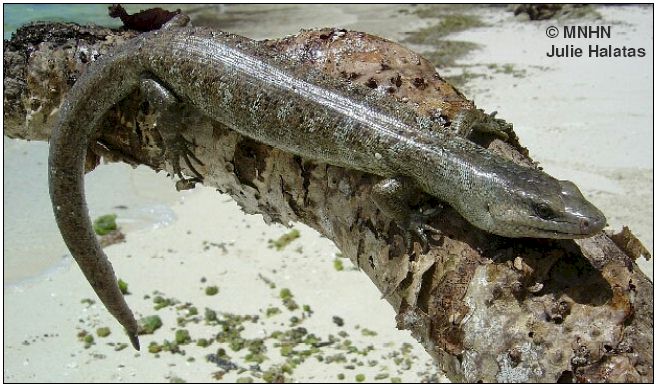Bocourt's giant skink rediscovered in New Caledonia
Considered extinct after the discovery of a single animal about 1870, the second ever known specimen of this species was found by scientists on a small islet in late 2003.
Document created 09 March 2004

A large lizard was captured in December 2003 by Ivan INEICH on a small islet off Ile des Pins, New Caledonia, during a mission of study on the marine snakes of New Caledonia (partnership CNRS, Sydney University, IRD and MNHN). Ivan INEICH is a scientist with the Department of Classification and Evolution (UMS 602 Taxonomy and collections) of the Natural History Museum in Paris.
The scientific name of this Scincidae is Phoboscincus bocourti. Measuring nearly 50 cm (20 in.) in total length, it was photographed and filmed before being released. Before this re-discovery Bocourt’s giant skink was known from a single specimen collected c. 1870 (and added to the Museum’s collections on 28 October 1872) by Benjamin Balansa, an excellent field botanist then working for the Museum. However Balansa did not visit Ile des Pins during his five year stay in New Caledonia (P. Morat, pers. comm.).
The scientific name of this Scincidae is Phoboscincus bocourti. Measuring nearly 50 cm (20 in.) in total length, it was photographed and filmed before being released. Before this re-discovery Bocourt’s giant skink was known from a single specimen collected c. 1870 (and added to the Museum’s collections on 28 October 1872) by Benjamin Balansa, an excellent field botanist then working for the Museum. However Balansa did not visit Ile des Pins during his five year stay in New Caledonia (P. Morat, pers. comm.).
On the basis of this specimen the species was described in 1876 by the French naturalist Paul-Louis-Antoine Brocchi of the Museum, under the name Eumeces bocourti (the genus Phoboscincus was created only in 1974 by the Australian herpetologist Allan Greer, a renowned specialist of this family of lizards). This name was chosen to honour Marie-Firmin Bocourt, a French zoologist and artist, also belonging to the Museum, who first recognised that this species had been as yet unknown. The National Museum of Natural History still holds Balansa’s specimen, which is similar in size to the individual found in 2003. The lack of sightings following the discovery was supposed to be linked to nocturnal life habits, and the species was considered extinct.
This animal has long, curved and sharp front teeth ; it is probably a fearsome super-predator of lizards and possibly birds, but its biology is still as yet completely unknown.
The rediscovery of this giant lizard on a tiny islet, in spite of previous prospection by numerous reptile specialists, is a strong message of hope for all those who are committed to preserving the considerable biodiversity of the French overseas territories.
This re-discovery will also provide encouragement to the Museum’s dwindling numbers of field naturalists who explore the world, sometimes at the peril of their life, in order to survey biodiversity and the threats which they are increasingly facing. According to Ivan INEICH other species considered extinct in the world may still be living in their natural environment (when it has not been degraded or destroyed), but thanks to specific living habits (burrowing or tree-living) they can be observed only in fugacious and exceptional circumstances.
Contact : Ivan INEICH [++ 33.1.40.79.34.92 – ++ 33.06.03.48.02.65 – ineich@mnhn.fr]
This animal has long, curved and sharp front teeth ; it is probably a fearsome super-predator of lizards and possibly birds, but its biology is still as yet completely unknown.
The rediscovery of this giant lizard on a tiny islet, in spite of previous prospection by numerous reptile specialists, is a strong message of hope for all those who are committed to preserving the considerable biodiversity of the French overseas territories.
This re-discovery will also provide encouragement to the Museum’s dwindling numbers of field naturalists who explore the world, sometimes at the peril of their life, in order to survey biodiversity and the threats which they are increasingly facing. According to Ivan INEICH other species considered extinct in the world may still be living in their natural environment (when it has not been degraded or destroyed), but thanks to specific living habits (burrowing or tree-living) they can be observed only in fugacious and exceptional circumstances.
Contact : Ivan INEICH [++ 33.1.40.79.34.92 – ++ 33.06.03.48.02.65 – ineich@mnhn.fr]
Links to external websites:
[wb1] MNHN's press release - Read for full text
[wb2] Museum National d'Histoire Naturelle - Click to access the Museum's website
Comments
No comment available for this document
Ratings
Not yet rated
Rate it
×

